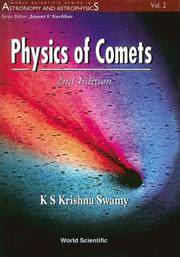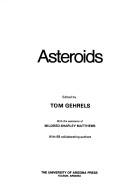| Listing 1 - 10 of 86 | << page >> |
Sort by
|
Book
ISBN: 9781316145166 9781107093492 1316145166 9781316204986 1316204987 110709349X 1316191982 1316212335 1316190153 1316210510 1316206785 1316208648 9781316191989 9781316212332 9781316190159 9781316210512 9781316206782 9781316208649 Year: 2015 Publisher: Cambridge
Abstract | Keywords | Export | Availability | Bookmark
 Loading...
Loading...Choose an application
- Reference Manager
- EndNote
- RefWorks (Direct export to RefWorks)
Throughout the ages, comets, enigmatic and beautiful wandering objects that appear for weeks or months, have alternately fascinated and terrified humankind. The result of five years of careful research, Atlas of Great Comets is a generously illustrated reference on thirty of the greatest comets that have been witnessed and documented since the Middle Ages. Special attention is given to the cultural and scientific impact of each appearance, supported by a wealth of images, from woodcuts, engravings, historical paintings and artifacts, to a showcase of the best astronomical photos and images. Following the introduction, giving the broad historical context and a modern scientific interpretation, the Great Comets feature in chronological order. For each, there is a contemporary description of its appearance along with its scientific, cultural and historical significance. Whether you are an armchair astronomer or a seasoned comet-chaser, this spectacular reference deserves a place on your shelf.
Book
ISBN: 9781620817001 1620817004 9781613246580 1613246587 Year: 2012 Publisher: Hauppauge, N.Y.
Abstract | Keywords | Export | Availability | Bookmark
 Loading...
Loading...Choose an application
- Reference Manager
- EndNote
- RefWorks (Direct export to RefWorks)
Book
ISBN: 1107503159 1139894021 1107517249 1107514452 1107506824 1107504147 1107497574 1107045258 Year: 2013 Publisher: Cambridge : Cambridge University Press,
Abstract | Keywords | Export | Availability | Bookmark
 Loading...
Loading...Choose an application
- Reference Manager
- EndNote
- RefWorks (Direct export to RefWorks)
Join David J. Eicher in this fast-paced and entertaining journey through the history, present, and future of these important yet mysterious cosmic bodies. From ancient times, humans have been fascinated by 'broom stars' and 'blazing scimitars' lighting up the sky and moving against the fixed background of stars. The Great Comets of our time still receive in-depth attention - ISON, Hale-Bopp, Hyakutake, West, and others - while recent spacecraft encounters offer amazing insight into the earliest days of the solar system. In this guide you will discover the cutting-edge science of what comets are, how they behave, where they reside, how groups of comets are related, and much more. The author carefully explores the ideas relating comets and life on Earth - and the danger posed by impacts. He finishes with practical, how-to techniques, tips, and tricks on how to successfully observe comets and even to capture your own images of them.
Book
ISBN: 9780511575310 9780521585071 9780511508189 0511508182 9780511504358 0511504357 0521585074 131608745X 0511508840 0511575319 051150649X Year: 2009 Publisher: Cambridge, UK New York Cambridge University Press
Abstract | Keywords | Export | Availability | Bookmark
 Loading...
Loading...Choose an application
- Reference Manager
- EndNote
- RefWorks (Direct export to RefWorks)
Cometography is a multi-volume catalog of every comet observed throughout history. It uses the most reliable orbits known to determine the distances from the Earth and Sun at the time a comet was discovered and last observed, as well as the largest and smallest angular distance to the Sun, most northerly and southerly declination, closest distance to the Earth, and other details to enable the reader to understand the physical appearance of each well-observed comet. Volume 4 provides a complete discussion of each comet seen from 1933 to 1959. It includes physical descriptions made throughout each comet's apparition. The comets are listed in chronological order, and each listing includes complete references to publications relating to the comet. This book is the most complete and comprehensive collection of comet data available, and provides amateur and professional astronomers, and historians of science, with a definitive reference on comets through the ages.
Comets --- Astronomy. --- Near-Earth objects
Book
ISBN: 0816507694 9780816507696 Year: 1983 Publisher: Tucson (AZ) : University of Arizona Press,
Abstract | Keywords | Export | Availability | Bookmark
 Loading...
Loading...Choose an application
- Reference Manager
- EndNote
- RefWorks (Direct export to RefWorks)
Comets --- 523.6 --- Near-Earth objects --- Comets.

ISBN: 9789812830258 9812830251 9810226322 9789810226329 Year: 1997 Publisher: Singapore River Edge, N.J. World Scientific
Abstract | Keywords | Export | Availability | Bookmark
 Loading...
Loading...Choose an application
- Reference Manager
- EndNote
- RefWorks (Direct export to RefWorks)
The study of Comet Halley in 1986 was a tremendous success for cometary science. In March of that year, six spacecrafts passed through Comet Halley as close as 600 km from the nucleus and made the in situ measurements of various kinds. These space missions to Comet Halley and that of the ICE spacecraft to Comet Giacobini-Zinner combined with studies, both ground-based and above the atmosphere, have increased our knowledge of cometary science in a dramatic way.This new edition of Physics of Comets incorporates these new and exciting findings. The emphasis of the book is on the physical processe
Comets. --- Solar system. --- Near-Earth objects
Book
Year: 2016 Publisher: Washington : U.S. Government Publishing Office,
Abstract | Keywords | Export | Availability | Bookmark
 Loading...
Loading...Choose an application
- Reference Manager
- EndNote
- RefWorks (Direct export to RefWorks)
Near-Earth objects. --- Near-Earth objects --- Near-earth asteroids. --- Asteroids --- Observations. --- Collisions with Earth --- Prevention.
Multi
ISBN: 9781400883554 9780691173337 9780691149295 0691173338 0691149291 1400883555 9781400844630 1400844630 Year: 2016 Publisher: Princeton, New Jersey
Abstract | Keywords | Export | Availability | Bookmark
 Loading...
Loading...Choose an application
- Reference Manager
- EndNote
- RefWorks (Direct export to RefWorks)
Of all the natural disasters that could befall us, only an Earth impact by a large comet or asteroid has the potential to end civilization in a single blow. Yet these near-Earth objects also offer tantalizing clues to our solar system's origins, and someday could even serve as stepping-stones for space exploration. In this book, Donald Yeomans introduces readers to the science of near-Earth objects-its history, applications, and ongoing quest to find near-Earth objects before they find us.In its course around the sun, the Earth passes through a veritable shooting gallery of millions of nearby comets and asteroids. One such asteroid is thought to have plunged into our planet sixty-five million years ago, triggering a global catastrophe that killed off the dinosaurs. Yeomans provides an up-to-date and accessible guide for understanding the threats posed by near-Earth objects, and also explains how early collisions with them delivered the ingredients that made life on Earth possible. He shows how later impacts spurred evolution, allowing only the most adaptable species to thrive-in fact, we humans may owe our very existence to objects that struck our planet.Yeomans takes readers behind the scenes of today's efforts to find, track, and study near-Earth objects. He shows how the same comets and asteroids most likely to collide with us could also be mined for precious natural resources like water and oxygen, and used as watering holes and fueling stations for expeditions to Mars and the outermost reaches of our solar system.
Pure sciences. Natural sciences (general) --- Near-Earth objects --- Asteroids --- Comets --- Near-Earth objects. --- Collisions with Earth.

ISBN: 0816506957 9780816506958 Year: 1979 Publisher: Tucson (Ariz.): University of Arizona press,
Abstract | Keywords | Export | Availability | Bookmark
 Loading...
Loading...Choose an application
- Reference Manager
- EndNote
- RefWorks (Direct export to RefWorks)
Planets, Minor --- Asteroids --- Minor planets --- Planetoids --- Near-Earth objects --- Asteroids.

ISBN: 2130445268 9782130445265 Year: 1993 Volume: 1236 Publisher: Paris: PUF,
Abstract | Keywords | Export | Availability | Bookmark
 Loading...
Loading...Choose an application
- Reference Manager
- EndNote
- RefWorks (Direct export to RefWorks)
Comets. --- 523.6 --- Near-Earth objects --- Comets --- Comètes
| Listing 1 - 10 of 86 | << page >> |
Sort by
|

 Search
Search Feedback
Feedback About UniCat
About UniCat  Help
Help News
News